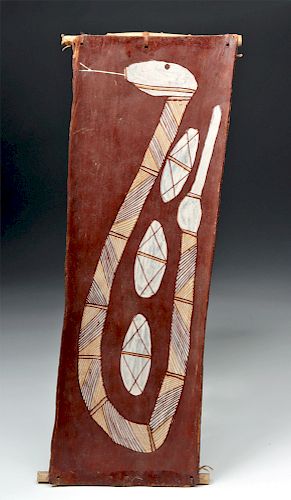20th C Signed Wanurr Namundja Aboriginal Bark Painting
Lot 43j
About Seller
Artemis Gallery
686 S Taylor Ave, Ste 106
Louisville, CO 80027
United States
Selling antiquities, ancient and ethnographic art online since 1993, Artemis Gallery specializes in Classical Antiquities (Egyptian, Greek, Roman, Near Eastern), Asian, Pre-Columbian, African / Tribal / Oceanographic art. Our extensive inventory includes pottery, stone, metal, wood, glass and textil...Read more
Categories
Estimate:
$1,800 - $2,700
Absentee vs Live bid
Two ways to bid:
- Leave a max absentee bid and the platform will bid on your behalf up to your maximum bid during the live auction.
- Bid live during the auction and your bids will be submitted real-time to the auctioneer.
Bid Increments
| Price | Bid Increment |
|---|---|
| $0 | $25 |
| $300 | $50 |
| $1,000 | $100 |
| $2,000 | $250 |
| $5,000 | $500 |
| $10,000 | $1,000 |
| $20,000 | $2,500 |
| $50,000 | $5,000 |
| $100,000 | $10,000 |
| $200,000 | $20,000 |
About Auction
By Artemis Gallery
May 10, 2018
Set Reminder
2018-05-10 10:00:00
2018-05-10 10:00:00
America/New_York
Bidsquare
Bidsquare : Fine Ethnographic / Asian / Ancient Art
https://www.bidsquare.com/auctions/artemis-gallery/fine-ethnographic-asian-ancient-art-3213
Featuring antiquities from around the world including Pre-Columbian, Tribal, Classical, Asian, so much more! Artemis Gallery info@artemisgallery.com
Featuring antiquities from around the world including Pre-Columbian, Tribal, Classical, Asian, so much more! Artemis Gallery info@artemisgallery.com
- Lot Description
Bob Wanur Namundja, also known as Wanurr Namundja (Australian, lived ca. 1922 to 2007), Mankorlod region of western Arnhem Land, ca. mid 20th century CE. Untitled bark painting. Signed on verso. Painted using natural earth pigments on a large strip of eucalyptus bark, this beautiful, colorful composition depicts a file snake (kedjebe, or Acrochrodus arafurae) with three eggs. The animal's body curves upward, forming a U-shape with the head perpendicular at the top of one side, the long tongue outstretched. The head and tail are mainly white, while the rest of the body is segmented, with thin, dense diagonal lines of yellow and dark red over a white background in each of the nine segments. The three eggs are white, divided in half by a band of yellow with red borders, and with two red X's, one on top and one on bottom of the band. All painted on a dark red background, with the white body of the snake in sharp contrast. Size: 9.25" W x 24.45" H (23.5 cm x 62.1 cm)
The kedjebe is a freshwater snake, found living in rivers, creeks, and billabongs (oxbow lakes), where it will burrow down into the mud. In the area where the artist was from, people wade out into the water during the dry season and reach into the mud to catch these non-venomous snakes. In the past, they would then kill them by taking the head in the mouth, biting it, and breaking the animal's neck. This painting was done in the age-old style of West Arnhem Land, which is part of the oldest continuous tradition of painting (from rock art to bark) known in the world. The colors are created from the ocher that is naturally occurring in the region.
The artist, alongside his brother, was featured in the exhibition "The Art of Two Brothers: Bob Wanur Namundja and Don Nakadilinj Namundja" at the Cross Art Projects in Sydney, Australia in late 2005. The curator, Andrew Blake, wrote, "The brothers pay homage to a bush life in their place, called Mankorlod, a place spiritually focal to the Kardbam clan. Their stylised paintings depict the beauty and mystique of the plants, animals, ancestors and creator beings, totems and myths associated with Mankorlod. Both men are Kunwinjku speakers of Nawakaji skin. Bob was the formal authority to Mankorlod… The brothers’ oddly metaphysical images describe a rich monsoonal forest pocket: livistona palms, noisy fruit bats and birds, possums in the rock ledges, snakes and echidnas, long yams and fruit and, in the waters made sacred by the Rainbow Serpent, lilies, fish and freshwater prawns."
A similarly-sized painting by the same artist sold at Sotheby's, London, in 2015 for approximately $3000: http://www.sothebys.com/en/auctions/ecatalogue/2015/aboriginal-art-thomas-vroom-collection-l15321/lot.16.html
Provenance: ex-private Tucson, Arizona, USA collection; ex-Ron Perry collection; Ron Perry collected art and artifacts for more than 40 years in New Guinea and the South Pacific. He collaborated with Carolyn Leigh to write a book entitled, "Art Dealer in the Last Unknown: Ron Perry & New Guinea Art: the early years 1964-1972" (2011)
All items legal to buy/sell under U.S. Statute covering cultural patrimony Code 2600, CHAPTER 14, and are guaranteed to be as described or your money back.
A Certificate of Authenticity will accompany all winning bids.
We ship worldwide and handle all shipping in-house for your convenience.
#130004Excellent condition, with light surface wear commensurate with age. Signature on the back along with the title of the painting, written in black ink.Condition
- Shipping Info
-
All shipping is handled in-house for your convenience. Your invoice from Artemis Gallery will include shipping calculation instructions. If in doubt, please inquire BEFORE bidding for estimated shipping costs for individual items.
-
- Buyer's Premium



 EUR
EUR CAD
CAD AUD
AUD GBP
GBP MXN
MXN HKD
HKD CNY
CNY MYR
MYR SEK
SEK SGD
SGD CHF
CHF THB
THB













